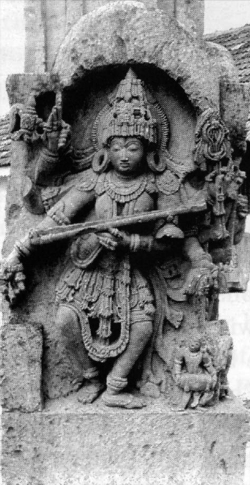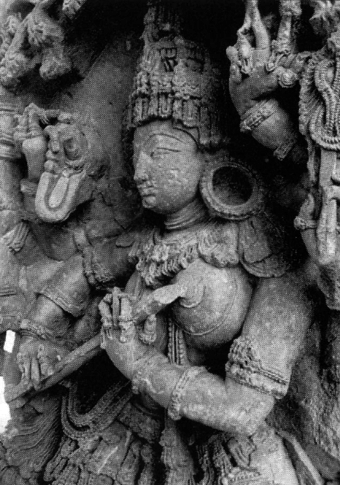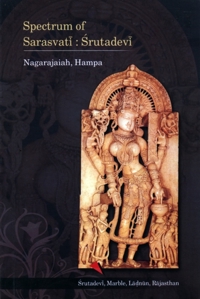 |
[53] Haḷebīḍu Museum |
 |
| [54] Haḷebīḍu, 12th cent. |
South Indian Sarasvatī sculptures, particularly in the Hoysaḷa period, broadly show uniformity of style. They are unique in invariably holding weapons in addition to other characteristic attributes of vīṇā, pustaka, akṣamālā (akṣamāni, akṣasūtra), and her mount either (Rāja)haṁsa or mayūra.
The Hoysaḷa epoch may be considered as the golden age for sculptures of Sarasvatī with delicately rendered ornaments. They are impressive both for their size and their ornate configuration. The sculptor's skilful creation of striking visual designs is admirable. To go a step further, the artists have granted the images a kind of immortality.
The propriety of this deity of wisdom depicted as the weapon-bearing goddess, as pointed out in the end of third chapter, needs justification. Practically, Sarasvatī is not conceptualized as a battle deity. Then, how is it that Karṇāṭaka sculptures of Sarasvatī carry weapons such as the stick and noose? 'The only Indian text in which a combative aspect of Sarasvatī emerges is the Ṛg Veda, where the powerful river goddess is invoked to conquer enemies and also compared to Indra. This fact, however, does not re-surface in subsequent Vedic, epic, or early Puranic texts, where Sarasvatī is transformed into a benevolent goddess of knowledge' [Ludvik 199].
Besides, such sculptures of similarities appeared because of prescribed sanction from Jaina śāstra-granthas, and again because of contemporary iconographic style that became popular in the Hoysaḷa period. Albeit, the concept of holding weapons is not altogether abandoned, since it has its roots in the Rg Veda. The Jaina concept of Sarasvatī, especially that of Śrutadevī, is more significant and immensely valuable to the study of the pan-Indian iconographic development of Sarasvatī and the way it was conceptualized. The Jaina images of an earlier date than most surviving ones acted as catalysts to augment the popularity of Sarasvatī cult.
 Prof. Dr. Nagarajaiah Hampana
Prof. Dr. Nagarajaiah Hampana
